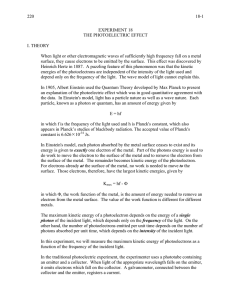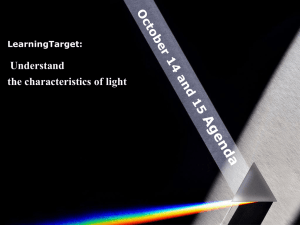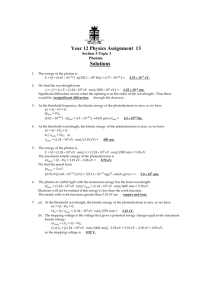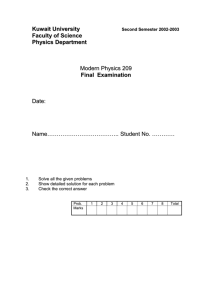270 11-1 EXPERIMENT 11 THE PHOTOELECTRIC EFFECT
advertisement
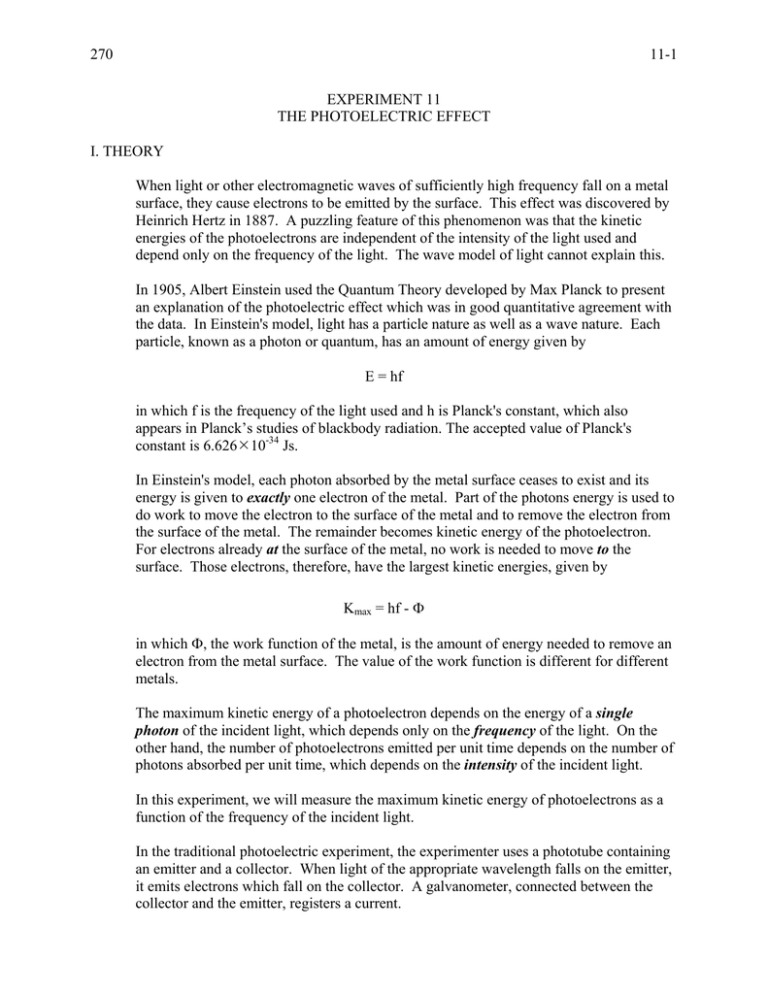
270 11-1 EXPERIMENT 11 THE PHOTOELECTRIC EFFECT I. THEORY When light or other electromagnetic waves of sufficiently high frequency fall on a metal surface, they cause electrons to be emitted by the surface. This effect was discovered by Heinrich Hertz in 1887. A puzzling feature of this phenomenon was that the kinetic energies of the photoelectrons are independent of the intensity of the light used and depend only on the frequency of the light. The wave model of light cannot explain this. In 1905, Albert Einstein used the Quantum Theory developed by Max Planck to present an explanation of the photoelectric effect which was in good quantitative agreement with the data. In Einstein's model, light has a particle nature as well as a wave nature. Each particle, known as a photon or quantum, has an amount of energy given by E = hf in which f is the frequency of the light used and h is Planck's constant, which also appears in Planck’s studies of blackbody radiation. The accepted value of Planck's constant is 6.626¯10-34 Js. In Einstein's model, each photon absorbed by the metal surface ceases to exist and its energy is given to exactly one electron of the metal. Part of the photons energy is used to do work to move the electron to the surface of the metal and to remove the electron from the surface of the metal. The remainder becomes kinetic energy of the photoelectron. For electrons already at the surface of the metal, no work is needed to move to the surface. Those electrons, therefore, have the largest kinetic energies, given by Kmax = hf - Φ in which Φ, the work function of the metal, is the amount of energy needed to remove an electron from the metal surface. The value of the work function is different for different metals. The maximum kinetic energy of a photoelectron depends on the energy of a single photon of the incident light, which depends only on the frequency of the light. On the other hand, the number of photoelectrons emitted per unit time depends on the number of photons absorbed per unit time, which depends on the intensity of the incident light. In this experiment, we will measure the maximum kinetic energy of photoelectrons as a function of the frequency of the incident light. In the traditional photoelectric experiment, the experimenter uses a phototube containing an emitter and a collector. When light of the appropriate wavelength falls on the emitter, it emits electrons which fall on the collector. A galvanometer, connected between the collector and the emitter, registers a current. 270 11-2 In order to measure the maximum kinetic energy of the photoelectrons for a given wavelength of light in the traditional experiment, a voltage is applied between the emitter and collector. The voltage is gradually increased until the galvanometer current is reduced to zero. We then have the equation Kmax = e VS in which e is the elementary charge, 1.60 x 10-19 C (coulombs, 1 C = 1 J/V), and VS is stopping potential. The traditional experiment is imprecise because it is difficult to know when the very small current has actually become zero. A small amount of photoelectric emission from the collector also complicates the situation. These problems are avoided in the present apparatus by replacing the galvanometer with a small capacitor. The capacitor charges up until its voltage is equal to the stopping potential. An ordinary voltmeter cannot be used to measure the voltage across a capacitor, so a high resistance solid state device senses the capacitor voltage and generates an equal voltage across output terminals, where it can be measured with an ordinary voltmeter. In order to control the wavelength of the light which falls on the emitter, we use a mercury vapor lamp. This lamp emits yellow, green and blue light, as well as two wavelengths of violet light, all in the visible range. It also emits infrared and ultraviolet wavelengths. We will use a combination lens-grating to focus the light and separate the wavelengths. Since second order ultraviolet light falls in the same position as first order yellow and green light, we must use filters to screen out the ultraviolet light when using the yellow and green lines. Since the shorter wavelength violet line is close to several ultraviolet lines, they all fall on the emitter together. We must use the highest frequency of the ultraviolet photons in our calculations, as that photon generates the most energetic photoelectrons. 270 11-3 II. LABORATORY PROCEDURE 1. Attach the lens-grating to the two horizontal rods of the mercury vapor lamp. Attach the photoelectric head to the lamp by connecting the arm to the base of the lamp. Connect the voltmeter to the OUTPUT terminals of the apparatus, but leave both off until step 10. 2. Put on goggles to protect your eyes from the ultraviolet light of the mercury vapor lamp. 3. Turn on the mercury vapor lamp. Darken the room. 4. The grating is blazed, producing a brighter spectrum on one side than on the other. Move the arm of the apparatus to one side so that the first order spectrum falls on the white surface surrounding the aperture. Repeat this on the other side and leave the arm on the side which has the brighter spectrum. 270 11-4 5. Position the arm so that the first order yellow line passes through the aperture. 6. Roll the cylindrical light shield out of the light path. Loosen the thumbscrew and rotate the apparatus on its supporting post so that the yellow light falls on the white sensitive surface of the phototube. Tighten the thumbscrew. NOTE: The white reflective mask on the h/e apparatus is made of a special fluorescent material. This allows you to see the ultraviolet line as a blue line, and it also makes the violet line appear more blue. You can see the actual colors of the light if you hold a piece of white non-fluorescent material in front of the mask. (The palm of your hand works in a pinch, although it fluoresces enough that the UV line will still be visible.) 7. Adjust the lens-grating for maximum concentration of the light on the sensitive surface. If necessary, do the adjustments of Steps 5 and 6 again. 8. Close the cylindrical light shield. 9. Place the yellow color filter over the aperture. It is held in place magnetically. Also place the transmission filter over the yellow color filter, in such a position that the 100 % transmission section is in the light path. 10. Turn the voltmeter on, using the 2 volt DC range. Turn the apparatus on. Record the reading on the voltmeter after it stabilizes. 11. Press and hold the ZERO button on the apparatus. Simultaneously release the ZERO button and start a stopwatch. As soon as the voltmeter reading exceeds 90% of the value recorded in Step 10, stop the stopwatch. Record the stopwatch reading. After the voltmeter reading stabilizes, record the voltmeter reading. 12. Repeat step 11 for each of the remaining transmission percentages (80%, 60%, 40% and 20%) of the transmission filter. Turn the voltmeter off. 13. Repeat Steps 5 through 10 for the green line, the blue line, and the two violet lines, but without the transmission filter. Of these, only the green line requires a color filter. You may need to use the 20 volt DC range of the voltmeter for one or both of the violet lines. 14. Turn the voltmeter and the apparatus off. 270 11-5 III. CALCULATIONS 1. Make a table containing the columns wavelength, frequency, stopping potential, and maximum kinetic energy (in joules). For the stopping potential of the yellow line, use the largest of the five voltages measured. The known wavelengths of the spectral lines are as follows: Line yellow green blue violet #1 violet #2 wavelength (nm) 578 546 436 405 365 The wavelength given for violet #1 is the smaller of two wavelengths close together. The wavelength given for violet #2 is the smallest of several visible and ultraviolet wavelengths. 2. Plot a graph of maximum kinetic energy versus frequency. Include the true origin (0, 0) on the graph. Leave room on the vertical axis for a negative intercept whose absolute value may be as large as 3 x 10-19 J. Draw the straight line that best fits the plotted points. Does the graph appear to be linear? 3. Use the Method of Least Squares to calculate the slope and intercept of your graph. Compare the intercept given by the Method of Least Squares to the one on your graph to check your calculation. 4. Using the results of Calculation 3, express the experimental value of Planck's constant in Js. Find the percent error for Planck's constant. 5. Using the results of Calculation 3, express the work function of the phototube emitter in joules and in electronvolts. 6. What is the physical interpretation of the intercept on the horizontal axis of your graph? 7. Explain why the five voltages measured for the yellow line with different transmission percentages are all approximately equal. 8. Explain why different lengths of time were measured when different transmission percentages were used. 9. Explain why the third order yellow line will not be seen. The grating has 600 lines/mm.
